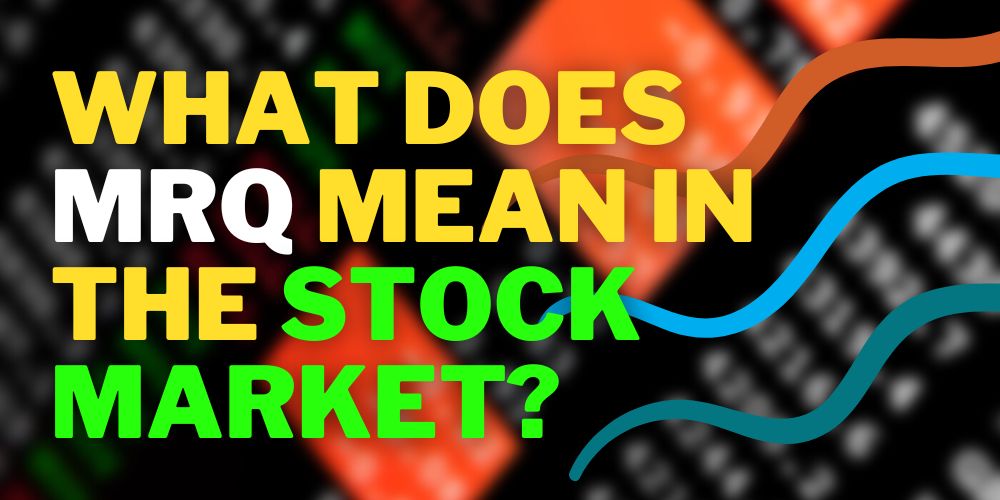There are all sorts of abbreviations and terms that can be confusing for beginners. MRQ is one such term, but what does MRQ mean in stocks? Keep on reading to know its significance to stock prices.
What Does MRQ Stand For?
MRQ stands for Most Recent Quarter. It is a financial metric that measures the reported performance of a company over the last three months.
It is often used to compare companies in similar industries and monitor quarter-to-quarter changes in company performance.
The division of a fiscal quarter usually looks like this:
- Quarter 1: January, February, and March
- Quarter 2: April, May, and June
- Quarter 3: July, August, and September
- Quarter 4: October, November, and December
 Normally, the most recent complete financial data will only be available once the quarter is over.
Normally, the most recent complete financial data will only be available once the quarter is over.
With this example, the MRQ, which would be Quarter 3 of 2022, will be used by the company when a potential investor asks for the most recent information in November 2022.
Companies typically publish their MRQ in financial statements using either accrued or actual numbers, so it’s best to understand which type of reporting is being used before making comparisons across different companies.
The MRQ usually has to be compared to the same period of the previous year for any meaningful insights to be derived from it.
What Does TTM Mean?
TTM, Trailing Twelve Months, is a popular financial metric for evaluating, comparing, and benchmarking companies.
This is because it permits users to assess a company’s historical performance without distortions caused by seasonal fluctuations or volatility.
It also allows comparison of the performance to competitors over time and can be used as part of an analysis of valuation metrics like P/E ratio, price-to-book ratio, etc. While TTM can provide valuable insight into a company’s health, it should not be relied on exclusively when making investment decisions.
While TTM can provide valuable insight into a company’s health, it should not be relied on exclusively when making investment decisions.
Many other essential factors must be carefully considered before acting on any given score or recommendation.
For example, management decisions and actions regarding new products or services, market mix changes, market shareholdings, and related activities may affect how well a company performs compared to dividend yields, earnings projections, and more.
What Is the Difference Between MRQ and TTM?
MRQ and TTM are two different approaches to analyzing financial data.
MRQ, or most recent quarter, refers to the most recently completed quarter of a company’s financial performance.
TTM, or trailing twelve months, looks at a company’s financial performance over the last 12 months, from the beginning of the current fiscal year up to (and including) the last completed month.
Book value per share, or BVPS, measures the intrinsic value of a company’s equity.
It’s calculated by dividing total assets minus intangible assets and liabilities by a company’s total number of shares outstanding. Intangible assets may include brand names and other items that have economic value but don’t appear on a balance sheet.
Intangible assets may include brand names and other items that have economic value but don’t appear on a balance sheet.
BVPS illustrates how much shareholders would receive if the company liquidated its assets and paid off all debts today.
This can be compared to the current share price to determine whether an investment in the stock is under or overvalued at current prices.
One way to assess the value of a stock is to look at its book value.
Generally, stocks with higher book values are more valuable than those with lower book values.
This makes sense, as higher book values indicate that the company has greater assets relative to liabilities.
Companies that have higher book values tend to be more stable because they are less likely to run into problems that would cause them to make significant losses.
Investors like high book values because they can be more confident in a company’s stability during tough economic times.
A high book value per share can suggest that a company’s stock may be undervalued – meaning it is trading below its actual worth.
Conversely, a low or negative book value per share could mean the company’s stock is overvalued – trading above its actual market price.
Of course, there are many other factors to consider when assessing the value of a stock, such as trends in market demand for products or services offered by the company and the quality of its management.
Book value per share is just one piece of the puzzle, but it can be a valuable indicator of a company’s true worth.
What Are the Benefits of MRQ, TTM, and BVPS?
Each of these metrics can provide valuable insight into how a company is doing and whether it’s a good investment opportunity.
Let’s take a closer look at each and explore their benefits for investors.
The MRQ metric provides information about how well a company performed in its most recent fiscal quarter compared to previous quarters and against industry peers.
For example, suppose Company X showed a significant increase in revenue over the most recent quarter but only a marginal increase compared to the same quarter last year.
In that case, this might indicate that Company X is struggling to keep up with industry trends.
However, if Company X showed an increase of 5% in revenue compared to Q2 last year and outperformed its peers by 3%, this would be considered a positive result.
Similarly, investors use TTM metrics to determine how well a company is performing and whether it’s worth investing in from a long-term perspective. The TTM metric measures performance over the past 12 months and can provide insight into seasonal changes or fluctuations in demand for a product or service.
The TTM metric measures performance over the past 12 months and can provide insight into seasonal changes or fluctuations in demand for a product or service.
For example, suppose Company Y reported a 5% growth in sales during the last quarter of the TTM period and an 8% growth in sales during the first quarter.
In that case, this may indicate that Company Y is experiencing a seasonal trend.
Finally, BVPS reveals the true worth of a company by looking at its common shareholder’s equity divided by shares outstanding by the end of the most recent interim period.
For example, if Company Z had $10 million in assets and $5 million in liabilities, its BVPS would be $5 million.
This metric can help investors determine whether a stock represents good value.
If Company Z’s stock was trading for $15 per share, but its BVPS was only $3.75, then it might indicate that the stock is overvalued and could potentially drop to reflect more accurately the actual value of the company.
Related: Do REITs Offer Tax Benefits?
Final Thoughts
In summary, MRQ is the quarter that just ended. TTM refers to the past twelve months and includes the MRQ.
BVPS tells you how much each share of stock is worth.
By understanding these terms discussed above, you’ll better understand a company’s overall financial picture, which could help you make more informed investment decisions.
You might also like:
How to Read The Stock Market : A Brief Guide


 Tags:
Tags:










